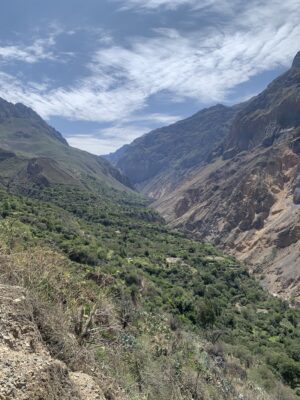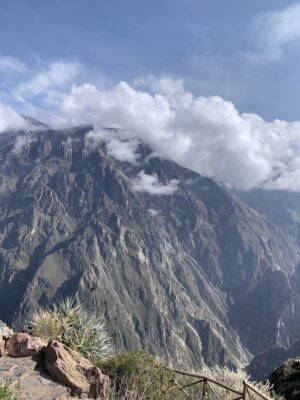Practical information
Colca Canyon, a breathtaking natural wonder located in the heart of Peru. As one of the deepest canyons in the world, Colca Canyon offers visitors a unique blend of stunning landscapes, rich cultural heritage, and exciting outdoor activities.
- Getting to Colca Canyon from Arequipa
- Buses: are a popular and affordable option, with several companies offering daily departures to Chivay.
- Car: To get to Colca Canyon from Arequipa, you can take a bus or a private car. The journey typically takes about 3-4 hours by road.
- Private tours and transfers: are also available, providing a more comfortable and flexible travel experience.
- Best time to visit: The best time to visit the canyon is during the dry season, which runs from May to November. During this time, the weather is pleasant, and the skies are clear, making it perfect for hiking and sightseeing. The dry season also offers the best chances to see the Andean condors, as they soar on the thermal currents in the canyon.
- Altitude: Colca Canyon is located at a high altitude, with the valley floor sitting around 3,600 meters (11,800 feet) above sea level. The surrounding peaks can reach up to 4,000 meters (13,123 feet) or more. Visitors should be prepared for the altitude and consider spending a few days in Arequipa to acclimatize before visiting the canyon.
- Duration of stay: A typical stay in canyon ranges from 2 to 3 days. This duration allows you to explore the main attractions, such as the Cruz del Condor viewpoint, various hot springs, and charming local villages. Longer stays can include more extensive hikes and deeper exploration of the canyon’s natural beauty and cultural heritage.
Most popular tours in the canyon
Other trips in the Colca Canyon
For which type of tour/attraction visit the Colca Canyon?
1. Cruz del Condor viewpoint: One of the most popular spots in Colca Canyon, this viewpoint offers stunning views of the canyon and is the best place to observe the majestic Andean condors as they glide on the thermal currents.
2. Hiking trails/treks: Colca Canyon boasts numerous hiking trails, ranging from short walks to multi-day treks. Popular routes include the descent into the canyon to the oasis town of Sangalle and the hike from Cabanaconde to Llahuar.
3. Hot springs: There are several hot springs in the Colca Canyon area, including La Calera near Chivay. These natural thermal baths are perfect for unwinding and enjoying the stunning surroundings.
4. Colca river: The river running through the canyon offers opportunities for adventure sports such as rafting, providing a thrilling way to experience the canyon’s natural beauty.
5. Chivay: The main town at the entrance of Colca Canyon, Chivay is known for its vibrant market, traditional Andean culture, and nearby hot springs, where you can relax after a day of exploring.
Tour types for visiting the Colca Canyon
1. Trekking tours: For those looking for adventure, trekking tours offer the chance to hike through the canyon, visit remote villages, and experience the stunning landscapes up close. These tours can vary from moderate to challenging levels.
2. Guided tours: These tours typically include transportation, accommodation, and a knowledgeable guide who can provide insights into the canyon’s history, culture, and wildlife. Options range from day trips to multi-day excursions.
4. Adventure tours: For thrill-seekers, adventure tours might include activities such as rafting on the Colca River, horseback riding, and mountain biking, providing an exhilarating way to explore the canyon.
3. Cultural tours: These tours focus on the cultural aspects of the Colca Valley, including visits to traditional villages, markets, and historical sites. They offer a deeper understanding of the local way of life and Andean traditions.
More information about Colca Canyon
This canyon is one of the deepest canyons in the world, with depths reaching over 3,200 meters (10,500 feet). The canyon has been inhabited for thousands of years by various indigenous groups, including the Collagua and Cabana peoples. These ancient cultures left behind a rich legacy, including impressive agricultural terraces that are still in use today.
The Spanish conquest in the 16th century brought significant changes to the region, including the construction of colonial churches and the introduction of new agricultural practices. Many of the villages in the Colca Valley still retain their colonial architecture and traditional customs, offering a glimpse into the area’s past.
Today, Colca Canyon is a popular tourist destination, known for its breathtaking scenery, rich cultural heritage, and opportunities for adventure. Visitors can explore the remnants of ancient civilizations, witness the Andean condors, and immerse themselves in the unique beauty of this region.





